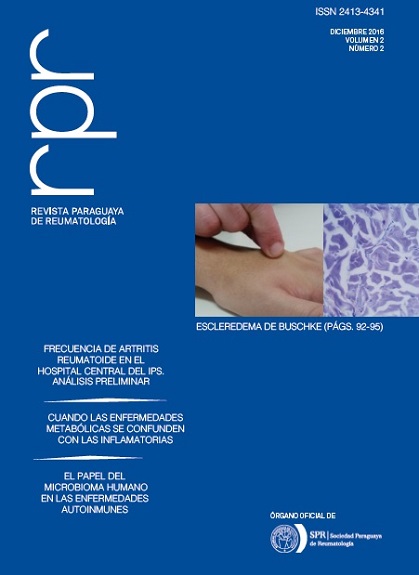Review of rehabilitation in scleroderma
Abstract
Scleroderma is a multisystem disease that involves the microvascular system and connective tissue. It is considered one of the most difficult rheumatic diseases to treat. Progression to functional disability requires rehabilitation with a multidisciplinary health team to improve the patient’s quality of life. Despite having poor prognosis, recent improvements in diagnosis and treatment have led to increased patient survival, by implementation of interventions that avoid progressive tissue fibrosis and contractures, and use of appropriate integrated rehabilitation programs. Current literature on rehabilitation techniques consists of studies that evaluate the effectiveness of paraffin wax treatment, manual lymphatic drainage, hand and face stretching exercises, connective tissue massage, joint manipulation, splints, and aerobic and resistance training. There are very few randomized controlled trials. Most studies have small sample sizes and lack control groups, but with the exception of splints, they have shown improvement in joint mobility and hand function with the aforementioned interventions.Downloads
References
(1) Schouffoer AA, Ninaber MK, Beaart-van de Voorde LJ, van der Giesen FJ, de Jong Z, Stolk J, Voskuyl AE et al. Randomized comparison of a multidisciplinary team care program with usual care in patients with systemic sclerosis. Arthritis Care Res (Hoboken). 2011;63(6):909-17.
(2) Randone SB, Guiducci S, Cerinic MM. Musculoskeletal involvement in systemic sclerosis. Best Pract Res Clin Rheumatol. 2008 Apr;22(2):339-50.
(3) Maddali Bongi S, Del Rosso A, Galluccio F, Tai G, Sigismondi F, Passalacqua M, et al. Efficacy of a tailored rehabilitation program for systemic sclerosis. Clin Exp Rheumatol. 2009;27(3 Suppl 54):44-50
(4) Maddali-Bongi S, Del Rosso A. Systemic sclerosis: rehabilitation as a tool to cope with disability. Clin Exp Rheumatol. 2016;34 Suppl 100(5):162-169.
(5) Cátedra-Vallés, E., M. García-Bascones, and A. B. Puentes-Gutierrez. ‟Drenaje linfático manual y presoterapia.” Rehabilitación. 2010: 63-67.
(6) Ezzo J, Manheimer E, McNeely ML, Howell DM, Weiss R, Johansson KI, Bao T, Bily L, Tuppo CM, Williams AF, Karadibak D. Manual lymphatic drainage for lymphedema following breast cancer treatment. Cochrane Database Syst Rev. 2015;21;(5):CD003475
(7) Bongi SM, Del Rosso A, Passalacqua M, Miccio S, Cerinic MM. Manual lymph drainage improving upper extremity edema and hand function in patients with systemic sclerosis in edematous phase. Arthritis Care Res (Hoboken). 2011;63(8):1134-41
(8) Leu AJ, Gretener SB, Enderlin S, Brühlmann P, Michel BA, Kowal-Bielecka O,Hoffmann U, Franzeck UK. Lymphatic microangiopathy of the skin in systemic sclerosis. Rheumatology (Oxford). 1999 Mar;38(3):221-7
(9) Pavez Ulloa, F. J. „Agentes físicos superficiales y dolor: análisis de su eficacia a la luz de la evidencia científica.“ Revista de la Sociedad Española del Dolor. 2009;182-189.
(10) Sandqvist G, Akesson A, Eklund M. Evaluation of paraffin bath treatment in patients with systemic sclerosis. Disabil Rehabil. 2004 Aug 19;26(16):981-7.
(11) Mancuso T, Poole JL. The effect of paraffin and exercise on hand function in persons with scleroderma: a series of single case studies. J Hand Ther. 2009;Jan-Mar;22(1):71-7.
(12) Vannajak K, Boonprakob Y, Eungpinichpong W, UngpansattawongS, Nanagara R. The short-term effect of gloving in combination with raditional Thai Massage, heat, and stretching exercise to improve hand mobility in scleroderma patients. J Ayurveda Integr Med. 2014;5(1):50-5.
(13) Bongi SM, Del Rosso A, Galluccio F, Sigismondi F, Miniati I, Conforti ML, Nacci F, Cerinic MM. Efficacy of connective tissue massage and Mc Mennell joint manipulation in the rehabilitative treatment of the hands in systemic sclerosis. Clin Rheumatol. 2009 Oct;28(10):1167-73.
(14) Seeger MW, Furst DE. Effects of splinting in the treatment of hand contractures in progressive systemic sclerosis. Am J Occup Ther. 1987;41(2):118-21.
(15) Casale R, Buonocore M, Matucci-Cerinic M. Systemic sclerosis (scleroderma): an integrated challenge in rehabilitation. Arch Phys Med Rehabil. 1997;78(7):767-73.
(16) Willems LM, Vriezekolk JE, Schouffoer AA, Poole JL, Stamm TA, Boström C, Kwakkenbos L, et al. Arthritis Care Res (Hoboken). 2015 Oct;67(10):1426-39
(17) Chernev I, Gustafson K, Medina-Bravo A. Functional outcome in a patient with an acute quadriparesis secondary to systemic sclerosis: a case report. Arch Phys Med Rehabil. 2009 Jan;90(1):170-2.2.
(18) Antonioli CM, Bua G, Frigè A, Prandini K, Radici S, Scarsi M, Danieli E,Malvicini A, Airo P. An individualized rehabilitation program in patients with systemic sclerosis may improve quality of life and hand mobility. Clin Rheumatol.2009 Feb;28(2):159-65.
(19) Oliveira NC, dos Santos Sabbag LM, de Sá Pinto AL, Borges CL, Lima FR. Aerobic exercise is safe and effective in systemic sclerosis. Int J Sports Med. 2009 Oct;30(10):728-32.
(20) Poole JL. Musculoskeletal rehabilitation in the person with scleroderma. Curr Opin Rheumatol. 2010;22(2):205-12.
(21) Maddali-Bongi S, Landi G, Galluccio F, Del Rosso A, Miniati I, Conforti ML. The rehabilitation of facial involvement in systemic sclerosis: efficacy of the combination of connective tissue massage, Kabat‘s technique and kinesitherapy: a randomized controlled trial. Rheumatol Int. 2011 Jul;31(7):895-901.
Copyright (c) 2016 Paraguayan Journal of Rheumatology

This work is licensed under a Creative Commons Attribution 4.0 International License.









